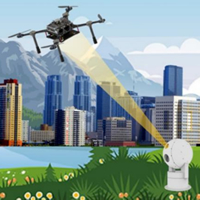
Optics-driven drone
Li X L, Huang G, Wang Z G, et al
Sci China Inf Sci, 2024, 67(2): 124201
In the field of vicinagearth security, low-altitude flying vehicles such as drones play an indispensable role in aerial remote sensing, intelligent search and rescue, etc. It can be foreseen that the autonomous and intelligent execution of complex tasks by drones is an inevitable trend for future development. However, due to the power density limitations of current chemical batteries, the endurance of drones is relatively short, which in turn limits their mission coverage radius, material delivery capacity, and information perception ability. In addition, the power supply of drones must also complete the landing and takeoff process. In fields such as power inspection and terrain mapping, frequent takeoff and landing pose a great risk of crashes and seriously affect operational efficiency. Oil-powered drones have strong endurance but poor stability, complex operation, and insufficient performance at high altitudes. Therefore, it is a major technical problem to develop a remote charging technology for drones to enhance their autonomy and intelligence during mission execution. It also has extremely high research significance and application value.